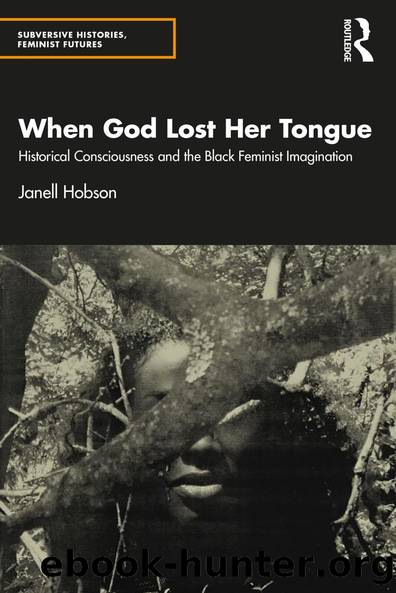When God Lost Her Tongue by Janell Hobson

Author:Janell Hobson [Hobson, Janell]
Language: eng
Format: epub
ISBN: 9780367198329
Google: aiRlzgEACAAJ
Publisher: Routledge
Published: 2021-09-30T03:58:20+00:00
Engaging in âchildâs playâ through this âtoy story,â Bennu suggests that such commercial items as a Barbie doll used in the portrayal of our heroic icon are ripe for subversion, especially in signifying on the proliferation of childrenâs stories about Tubman. The very depiction of âBlack Moses Barbieâ with a âmotivational freedom rifleâ accessory â in lieu of clothing, jewelry, and cosmetics â reminds us of the satirical ways that marginalized artists and communities have routinely flipped the scripts from dominant culture to assert and make legible our own stories and histories. Although mainstream American narratives have relegated Harriet Tubman to the safe confines of childrenâs literature and elementary-school education, she looms large in African American art, which means that fantasy â more than history â does the work of memorialization and monument-making, as seen in Lawrenceâs art series, for instance.
The celebration of folk heroes during the Great Depression within African American art, as depicted in Lawrenceâs series, is earlier reflected in Harlem Renaissance artist Aaron Douglasâs Harriet Tubman mural (1931) at Bennett College for Women in Greensboro, North Carolina. Such artistic expressions also emerged with the Civil Rights era, which revitalized the symbols of Black history, especially in the mobilization of African American spirituals that were passed down from slavery and recast as âfreedom songsâ during a movement that included freedom marches and freedom rides. Out of this zeitgeist emerged a new assertion of Black pride and Black feminism in which the icon of Tubman resurfaced in Black liberation politics.
Artworks by Faith Ringgold (with her 1972 Feminist Landscape tanka-based series featuring Tubman) and Elizabeth Catlett (with her 1975 linocut titled Harriet) appeared alongside the political work of Black feminist organizations such as the Combahee River Collective (named for Tubmanâs military campaign on the Combahee River) and the literary works of Black women writers who flourished during this era as they highlighted the intersections of racism and sexism in their experiences and turned to the historic examples of women like Tubman to refute Black nationalist arguments for Black male leadership and Black female submission. In her seminal historical work, Women, Race, & Class, Angela Davis reminds us of ânumerous women [like Harriet Tubman who] fled slavery for the North. Many were successful, though many more were captured,â thus disrupting the idea that Tubman was âthe exception rather than the rule.â14 This suggestion that Tubmanâs leadership abilities are qualities that she shared with other Black women aligned with second-wave Black feminist politics.
In reminiscing on her experiences in mounting her Feminist Landscape series, Faith Ringgold describes the following encounter with her artwork on Tubman:
Back in the early seventies black women were in denial of their oppression in order to be in support of their men. This made it very important for me to put the words of . . . valiant black feminists in my art so that people could read them and be as inspired as I had been. At one exhibition, however, a college student was moved to destroy one of the Feminist Landscapes.
Download
This site does not store any files on its server. We only index and link to content provided by other sites. Please contact the content providers to delete copyright contents if any and email us, we'll remove relevant links or contents immediately.
Cecilia; Or, Memoirs of an Heiress — Volume 1 by Fanny Burney(32054)
Cecilia; Or, Memoirs of an Heiress — Volume 3 by Fanny Burney(31453)
Cecilia; Or, Memoirs of an Heiress — Volume 2 by Fanny Burney(31402)
The Great Music City by Andrea Baker(30779)
We're Going to Need More Wine by Gabrielle Union(18626)
All the Missing Girls by Megan Miranda(14711)
Pimp by Iceberg Slim(13774)
Bombshells: Glamour Girls of a Lifetime by Sullivan Steve(13681)
Fifty Shades Freed by E L James(12908)
Talking to Strangers by Malcolm Gladwell(12865)
Norse Mythology by Gaiman Neil(12820)
For the Love of Europe by Rick Steves(11446)
Crazy Rich Asians by Kevin Kwan(8883)
Mindhunter: Inside the FBI's Elite Serial Crime Unit by John E. Douglas & Mark Olshaker(8699)
The Lost Art of Listening by Michael P. Nichols(7157)
Enlightenment Now: The Case for Reason, Science, Humanism, and Progress by Steven Pinker(6869)
The Four Agreements by Don Miguel Ruiz(6311)
Bad Blood by John Carreyrou(6271)
Weapons of Math Destruction by Cathy O'Neil(5825)
